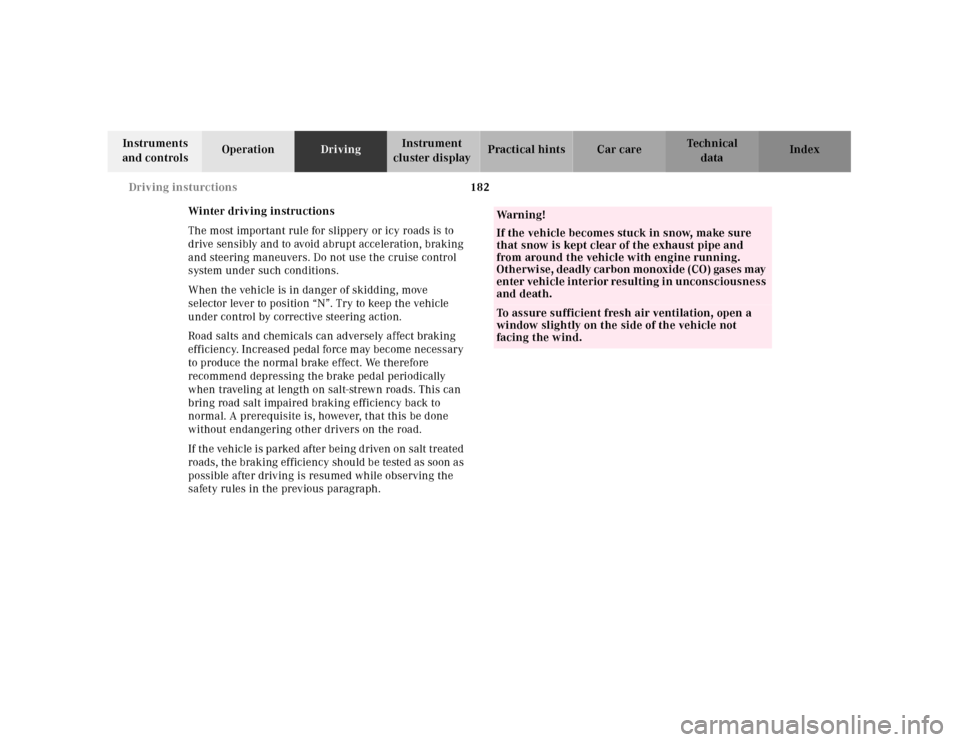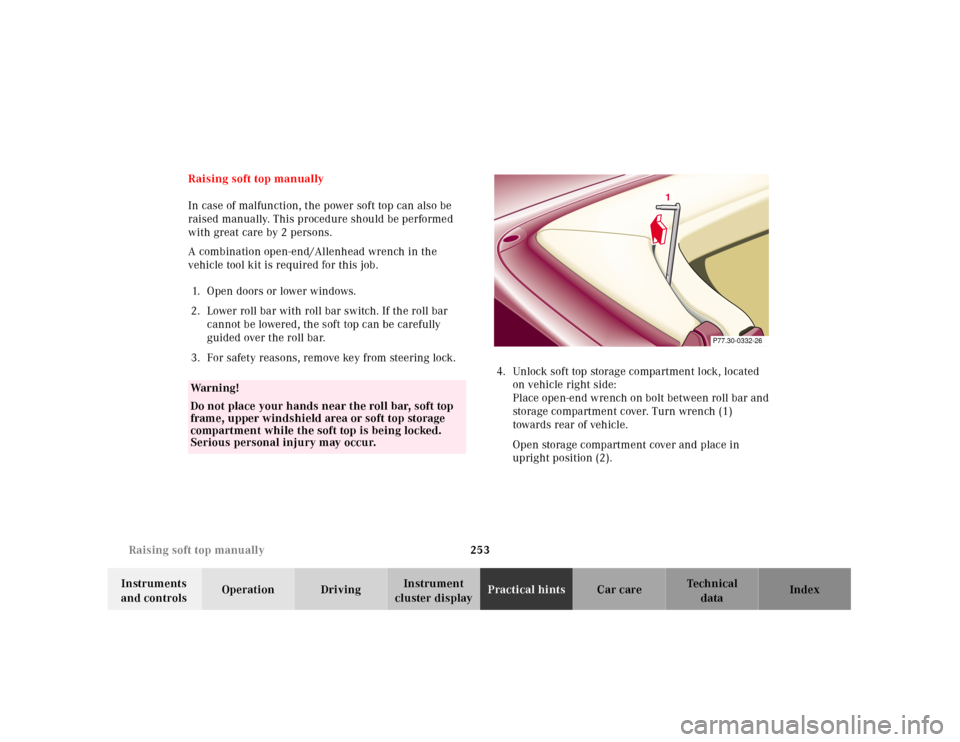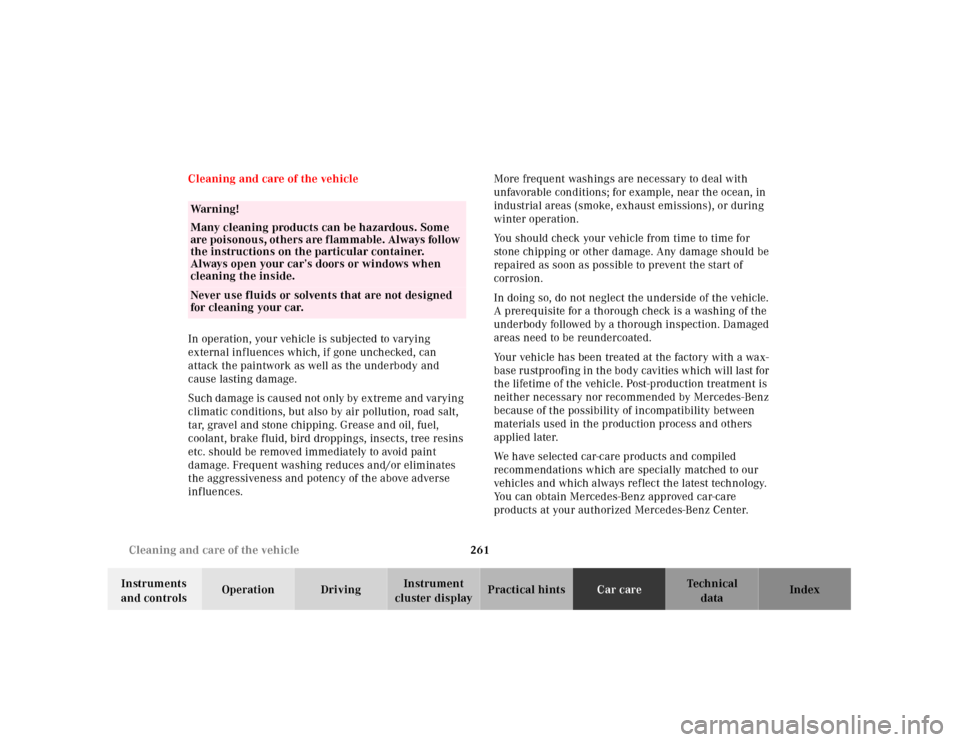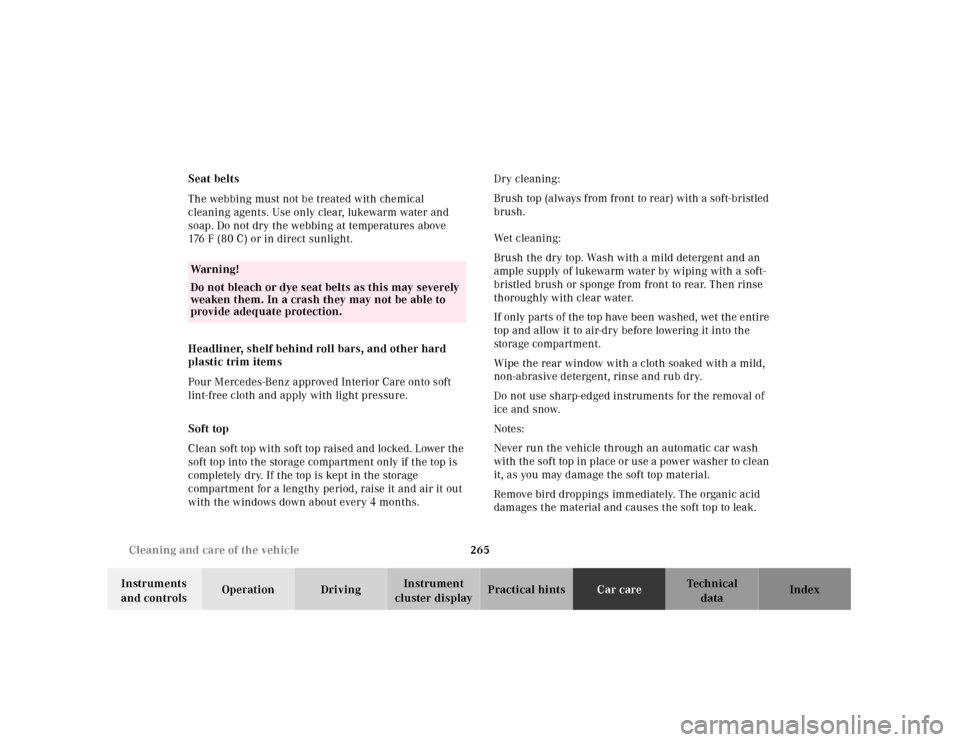2000 MERCEDES-BENZ SL600 window
[x] Cancel search: windowPage 170 of 297

166 Steering lock
Technical
data Instruments
and controlsOperationDrivingInstrument
cluster displayPractical hints Car care Index
Notes:
A warning sounds when the driver’s door is opened
while the key is in steering lock position 1 or 0.
With the engine at idle speed, the charging rate of the
alternator (output) is limited.
It is therefore recommended that you turn off
unnecessary electrical consumers while driving in stop-
and-go traffic. This precaution helps to avoid draining of
the battery.
Unnecessary strain on the battery and charging system
may be minimized by turning off the following power
consumers, for example: Heated seats, rear window
defroster.Caution!
To prevent accelerated battery discharge and a possible
dead battery, always remove the key from the steering
lock. Do not leave the key in steering lock position 0.
Page 186 of 297

182 Driving insturctions
Technical
data Instruments
and controlsOperationDrivingInstrument
cluster displayPractical hints Car care Index
Winter driving instructions
The most important rule for slippery or icy roads is to
drive sensibly and to avoid abrupt acceleration, braking
and steering maneuvers. Do not use the cruise control
system under such conditions.
When the vehicle is in danger of skidding, move
selector lever to position “N”. Try to keep the vehicle
under control by corrective steering action.
Road salts and chemicals can adversely affect braking
efficiency. Increased pedal force may become necessary
to produce the normal brake effect. We therefore
recommend depressing the brake pedal periodically
when traveling at length on salt-strewn roads. This can
bring road salt impaired braking efficiency back to
normal. A prerequisite is, however, that this be done
without endangering other drivers on the road.
If th e veh ic le is pa rked af ter being d riven on salt treated
roads, th e bra king ef f iciency sh ou ld b e teste d as soon a s
possible after driving is resumed while observing the
safety rules in the previous paragraph.
Wa r n i n g !
If the vehicle becomes stuck in snow, make sure
that snow is kept clear of the exhaust pipe and
from around the vehicle with engine running.
Otherwise, deadly carbon monoxide (CO) gases may
enter vehicle interior resulting in unconsciousness
and death.To assure sufficient fresh air ventilation, open a
window slightly on the side of the vehicle not
facing the wind.
Page 241 of 297

237 Battery
Technical
data Instruments
and controlsOperation DrivingInstrument
cluster displayPractical hintsCar care Index Do not close a door with the windows fully closed while
the power supply is interrupted (battery disconnected or
empty).
Doing so could damage the window frame.
Note:
After reconnecting the battery also set the clock,
resynchronize the express feature of the power
windows, the electronic stability program (ESP) and the
adaptive damping System (ADS).
See page 79 for setting clock, page 41 for power
windows, page 193 for ESP and page 199 for ADS. Battery Recycling
Batteries contain materials that can harm the
environment with improper disposal.
Large 12 Volt storage batteries contain lead.
Recycling of batteries is the preferred method of
disposal.
Many states require sellers of batteries to accept old
batteries for recycling.
Page 257 of 297

253 Raising soft top manually
Technical
data Instruments
and controlsOperation DrivingInstrument
cluster displayPractical hintsCar care Index Raising soft top manually
In case of malfunction, the power soft top can also be
raised manually. This procedure should be performed
with great care by 2 persons.
A combination open-end/Allenhead wrench in the
vehicle tool kit is required for this job.
1. Open doors or lower windows.
2. Lower roll bar with roll bar switch. If the roll bar
cannot be lowered, the soft top can be carefully
guided over the roll bar.
3. For safety reasons, remove key from steering lock.
4. Unlock soft top storage compartment lock, located
on vehicle right side:
Place open-end wrench on bolt between roll bar and
storage compartment cover. Turn wrench (1)
towards rear of vehicle.
Open storage compartment cover and place in
upright position (2).
Wa r n i n g !
Do not place your hands near the roll bar, soft top
frame, upper windshield area or soft top storage
compartment while the soft top is being locked.
Serious personal injury may occur.
P77.30-0332-26
1
Page 264 of 297

260 Contents – Vehicle care
Technical
data Instruments
and controlsOperation DrivingInstrument
cluster displayPractical hints Car care Index
Vehicle careCleaning and care
of the vehicle ............................. 261
Power washer ..............................262
Tar stains .....................................262
Paintwork, Painted Body
Components ................................262
Engine cleaning ..........................263
Vehicle washing .........................263Ornamental moldings ............... 263
Headlamps, taillamps,
turn signal lenses ...................... 263
Window cleaning ....................... 264
Light alloy wheels ..................... 264
Instrument cluster ..................... 264
Steering wheel and
gear selector lever ..................... 264
Cup holder .................................. 264
Seat belts ..................................... 265
Headliner, shelf behind
roll bars, and other hard
plastic trim items ....................... 265Soft top .........................................265
Headliner .....................................266
Wind screen ................................266
Automatic antenna .....................266
Wiper blade .................................266
Headlamp cleaning system .......266
Leather upholstery .....................267
Plastic and rubber parts ............267
Illuminated door sill panels .....267
Page 265 of 297

261 Cleaning and care of the vehicle
Technical
data Instruments
and controlsOperation DrivingInstrument
cluster displayPractical hintsCar careIndex Cleaning and care of the vehicle
In operation, your vehicle is subjected to varying
external inf luences which, if gone unchecked, can
attack the paintwork as well as the underbody and
cause lasting damage.
Such damage is caused not only by extreme and varying
climatic conditions, but also by air pollution, road salt,
tar, gravel and stone chipping. Grease and oil, fuel,
coolant, brake fluid, bird droppings, insects, tree resins
etc. should be removed immediately to avoid paint
damage. Frequent washing reduces and/or eliminates
the aggressiveness and potency of the above adverse
influences.More frequent washings are necessary to deal with
unfavorable conditions; for example, near the ocean, in
industrial areas (smoke, exhaust emissions), or during
winter operation.
You should check your vehicle from time to time for
stone chipping or other damage. Any damage should be
repaired as soon as possible to prevent the start of
corrosion.
In doing so, do not neglect the underside of the vehicle.
A prerequisite for a thorough check is a washing of the
underbody followed by a thorough inspection. Damaged
areas need to be reundercoated.
Your vehicle has been treated at the factory with a wax-
base ru stproof ing in th e body cavities w hich will la st for
the lifetime of the vehicle. Post-production treatment is
neither necessary nor recommended by Mercedes-Benz
because of the possibility of incompatibility between
materials used in the production process and others
applied later.
We have selected car-care products and compiled
recommendations which are specially matched to our
vehicles and which always reflect the latest technology.
You can obtain Mercedes-Benz approved car-care
products at your authorized Mercedes-Benz Center.
Wa r n i n g !
Many cleaning products can be hazardous. Some
are poisonous, others are flammable. Always follow
the instructions on the particular container.
Always open your car’s doors or windows when
cleaning the inside.Never use fluids or solvents that are not designed
for cleaning your car.
Page 268 of 297

264 Cleaning and care of the vehicle
Technical
data Instruments
and controlsOperation DrivingInstrument
cluster displayPractical hintsCar careIndex
Window cleaning
Use a window cleaning solution on all glass surfaces. An
automotive glass cleaner is recommended.
Note:
For safety reasons, switch off wiper and remove key
from steering lock before cleaning the windshield,
otherwise the wiper motor can suddenly turn on and
cause injury.
Light alloy wheels
Mercedes-Benz approved Wheel Care should be used for
regular cleaning of the light alloy wheels.
If possible, clean wheels once a week with
Mercedes-Benz approved Wheel Care, using a soft
bristle brush and a strong spray of water.
Follow instructions on container.
Note:
Use only acid-free cleaning materials. The acid could
lead to corrosion.Instrument cluster
Use a gentle dishwashing detergent or mild detergent
for delicate fabrics as a washing solution. Wipe with a
cloth moistened in lukewarm solution. Do not use
scouring agents.
Steering wheel and gear selector lever
Wipe with a damp cloth and dry thoroughly or clean
with Mercedes-Benz approved Leather Care.
Cup holder
Use a gentle dishwashing detergent or mild detergent
for delicate fabrics as a washing solution. Wipe with a
cloth moistened in lukewarm solution. Do not use
scouring agents.
Note:
For ease of cleaning, the cup holder between the front
seats can be removed by pulling it up when in its closed
position.
Page 269 of 297

265 Cleaning and care of the vehicle
Technical
data Instruments
and controlsOperation DrivingInstrument
cluster displayPractical hintsCar careIndex Seat belts
The webbing must not be treated with chemical
cleaning agents. Use only clear, lukewarm water and
soap. Do not dry the webbing at temperatures above
176 F (80 C) or in direct sunlight.
Headliner, shelf behind roll bars, and other hard
plastic trim items
Pour Mercedes-Benz approved Interior Care onto soft
lint-free cloth and apply with light pressure.
Soft top
Clean soft top with soft top raised and locked. Lower the
soft top into the storage compartment only if the top is
completely dry. If the top is kept in the storage
compartment for a lengthy period, raise it and air it out
with the windows down about every 4 months. Dry cleaning:
Brush top (always from front to rear) with a soft-bristled
brush.
Wet cleaning:
Brush the dry top. Wash with a mild detergent and an
ample supply of lukewarm water by wiping with a soft-
bristled brush or sponge from front to rear. Then rinse
thoroughly with clear water.
If only parts of the top have been washed, wet the entire
top and allow it to air-dry before lowering it into the
storage compartment.
Wipe the rear window with a cloth soaked with a mild,
non-abrasive detergent, rinse and rub dry.
Do not use sharp-edged instruments for the removal of
ice and snow.
Notes:
Never run the vehicle through an automatic car wash
with th e sof t top in pla ce or use a power wa sher to cl ean
it, as you may damage the soft top material.
Remove bird droppings immediately. The organic acid
damages the material and causes the soft top to leak.
Wa r n i n g !
Do not bleach or dye seat belts as this may severely
weaken them. In a crash they may not be able to
provide adequate protection.